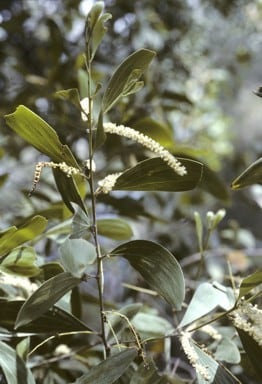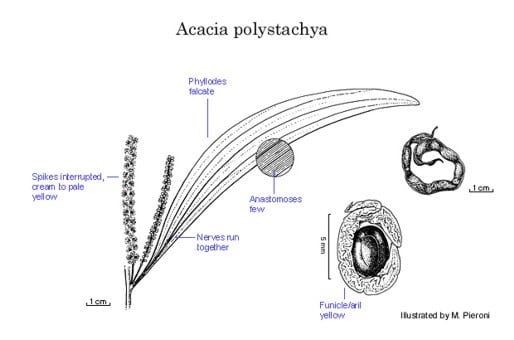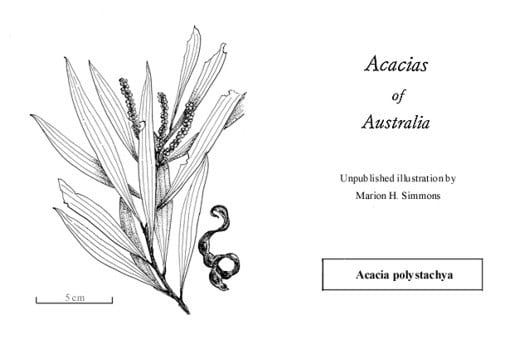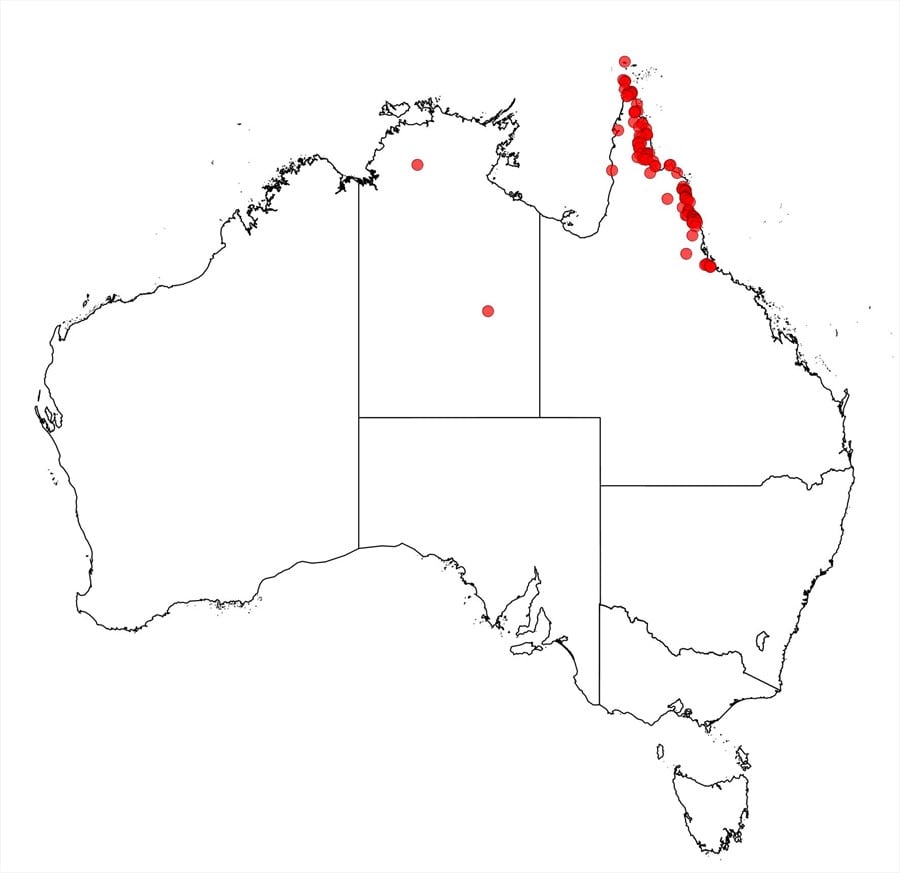Acacia polystachya A.Cunn. ex Benth.
WATTLE
Acacias of Australia
Family
Fabaceae
Distribution
Ranges from Banks Is., Torres Strait, S on Cape York along the coast to 17ºS; also recorded from Palm Is.
Description
Tree 3–25 m high. Bark smooth to corrugated or coarsely plaited, grey or dark brown. Branchlets angular or ±flattened, grey, brown or purplish, smooth or pustulate. Phyllodes very narrowly elliptic to narrowly elliptic, sometimes asymmetrical, ±straight to falcate, (7.5–) 9–17 (–25.5) cm long, 10–32 (–40) mm wide, ±chartaceous, glabrous, multistriate with 2 or 3 (rarely 4) more prominent nerves which often run together and join some distance above phyllode base and remain separate from lower margin; minor nerves 5–9 per mm, sparingly anastomosing; gland 1, basal, to 3 mm above pulvinus. Spikes 3.5–7.5 cm long, loosely arranged, pale yellow. Flowers 5-merous; calyx 0.4–0.7 mm long, dissected to 1/2, glabrous; corolla 1.6–1.8 mm long, dissected to 1/2, glabrous; ovary densely pubescent. Pods ±straight-sided to slightly and often irregularly more deeply constricted between seeds, curved to strongly curved, openly coiled or irregularly twisted, 8.5–13 cm long, 6–10 mm wide, thinly coriaceous, blackish, often pruinose, glabrous. Seeds longitudinal, ±discoid, 3.5–4.2 mm long, black, minutely pitted; pleurogram without halo; areole elongate, open; funicle encircling seed, yellow.
Phenology
Flowers Apr.–July.
Habitat
Grows in alluvial soils often near watercourses in semideciduous mesophyll vine thicket and deciduous vine thicket or along beaches.
Specimens
Qld: 106 km by road NNW of Coen along the Kennedy road, R.G.Coveny 7079 & P.D.Hind (A, BRI, CANB, K, L, MEL, TL, US); 5 miles [8 km] from Mossman towards Cairns, C.H.Gittins 1885 (NSW); Fall Ck; Pascoe R., P.Hind 1057 & C.K.Ingram (CANB, MEL, NSW); Yorkeys Knob Beach, Cairns, H.S.McKee 9489 (NSW); Coen, Apr. 1922, N.B.Tindale (NSW).
Notes
One of the specimens cited in the protologue collected by Armstrong at Port Essington is A. leptocarpa. Acacia polystachya putatively hybridizes with both A. leptocarpa and A. nesophila in northeast Qld. Although this species is not closely related to A. auriculiformis, it is difficult to distinguish if pods are unavailable; it is sometimes sympatric with, and superficially resembles, A. midgleyi.
Details of ecology, utilisation etc. are given in J.W.Turnbull (ed.), Multipurpose Austral. Trees & Shrubs 186 (1986).
FOA Reference
Data derived from Flora of Australia Volumes 11A (2001), 11B (2001) and 12 (1998), products of ABRS, ©Commonwealth of Australia
Author
Dr M.D.Tindale and Dr P.G.Kodela with the assistance of M.Bedward, S.J.Davies, C.Herscovitch, D.A.Keith and/or D.A.Morrison
Minor edits by B.R.Maslin & J.Rogers
This identification key and fact sheets are available as a mobile application:
URL: https://apps.lucidcentral.org/wattle/
© Copyright 2018. All rights reserved.









